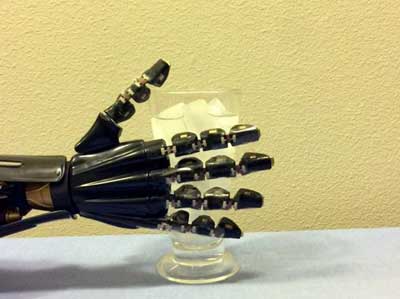| Posted: Sep 13, 2017 |
Artificial nanowire 'skin' gives robotic hand a sense of touch
(Nanowerk News) A team of researchers from the University of Houston has reported a breakthrough in stretchable electronics that can serve as an artificial skin, allowing a robotic hand to sense the difference between hot and cold, while also offering advantages for a wide range of biomedical devices.
|
|
The work, reported in the journal Science Advances ("Rubbery electronics and sensors from intrinsically stretchable elastomeric composites of semiconductors and conductors"), describes a new mechanism for producing stretchable electronics, a process that relies upon readily available materials and could be scaled up for commercial production.
|
 |
| Researchers from the University of Houston have reported a breakthrough in stretchable electronics that can serve as an artificial skin, allowing a robotic hand to sense the difference between hot and cold. (Image: University of Houston)
|
|
Cunjiang Yu, Bill D. Cook Assistant Professor of mechanical engineering and lead author for the paper, said the work is the first to create a semiconductor in a rubber composite format, designed to allow the electronic components to retain functionality even after the material is stretched by 50 percent.
|
|
The work is the first semiconductor in rubber composite format that enables stretchability without any special mechanical structure, Yu said.
|
|
He noted that traditional semiconductors are brittle and using them in otherwise stretchable materials has required a complicated system of mechanical accommodations. That's both more complex and less stable than the new discovery, as well as more expensive, he said.
|
|
"Our strategy has advantages for simple fabrication, scalable manufacturing, high-density integration, large strain tolerance and low cost," he said.
|
|
Yu and the rest of the team - co-authors include first author Hae-Jin Kim, Kyoseung Sim and Anish Thukral, all with the UH Cullen College of Engineering - created the electronic skin and used it to demonstrate that a robotic hand could sense the temperature of hot and iced water in a cup. The skin also was able to interpret computer signals sent to the hand and reproduce the signals as American Sign Language.
|
|
"The robotic skin can translate the gesture to readable letters that a person like me can understand and read," Yu said.
|
|
The artificial skin is just one application. Researchers said the discovery of a material that is soft, bendable, stretchable and twistable will impact future development in soft wearable electronics, including health monitors, medical implants and human-machine interfaces.
|
|
The stretchable composite semiconductor was prepared by using a silicon-based polymer known as polydimethylsiloxane, or PDMS, and tiny nanowires to create a solution that hardened into a material which used the nanowires to transport electric current.
|
|
"We foresee that this strategy of enabling elastomeric semiconductors by percolating semiconductor nanofibrils into a rubber will advance the development of stretchable semiconductors, and ... will move forward the advancement of stretchable electronics for a wide range of applications, such as artificial skins, biomedical implants and surgical gloves," they wrote.
|

